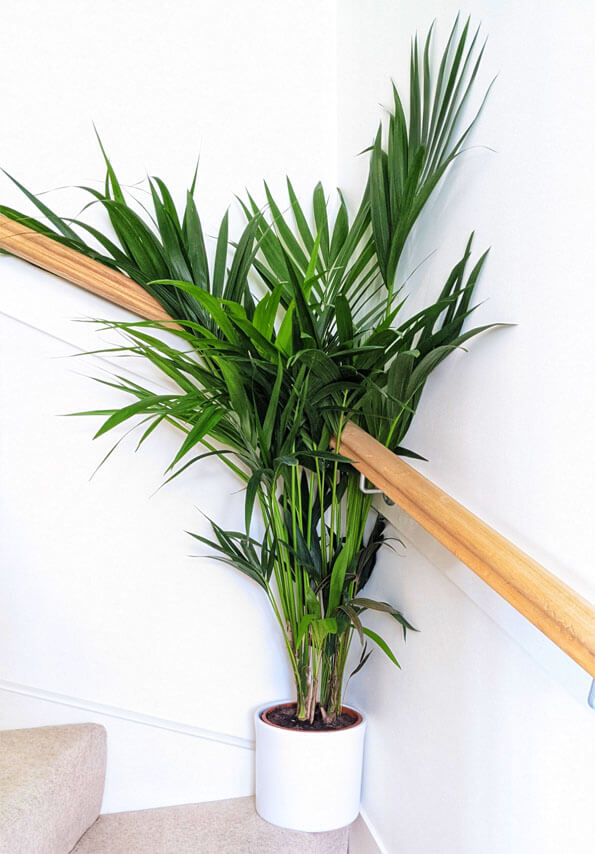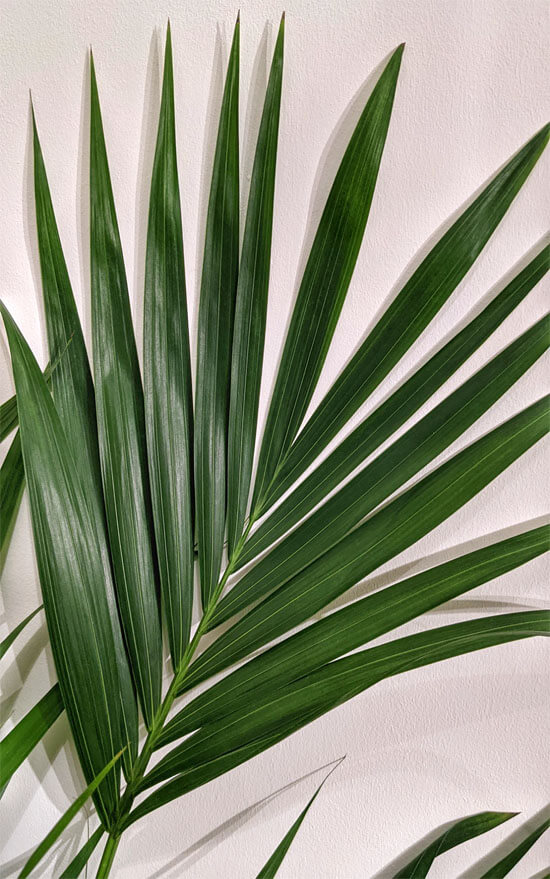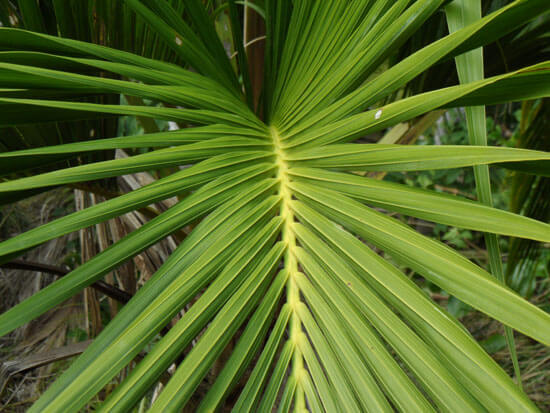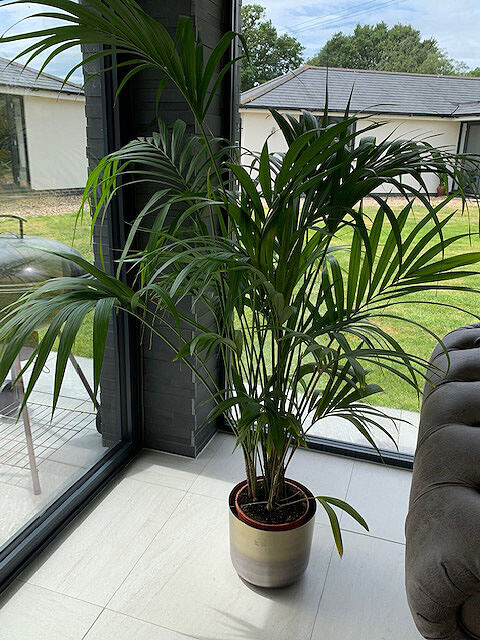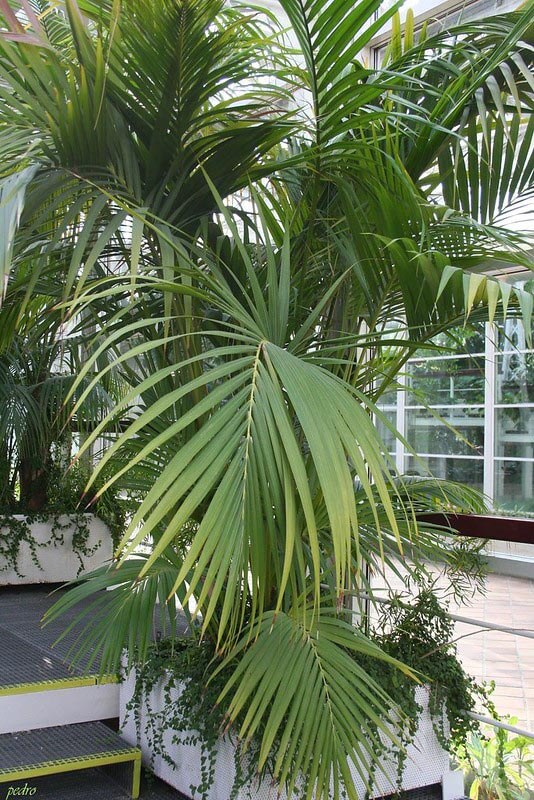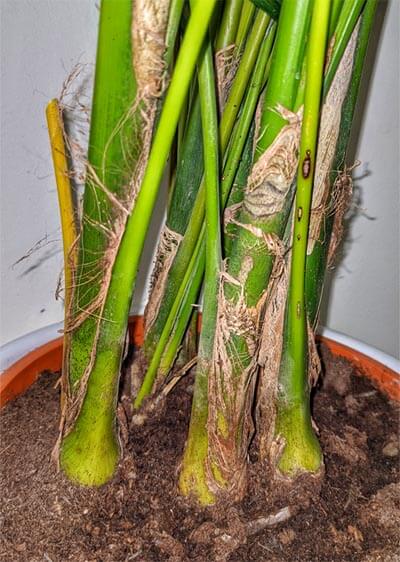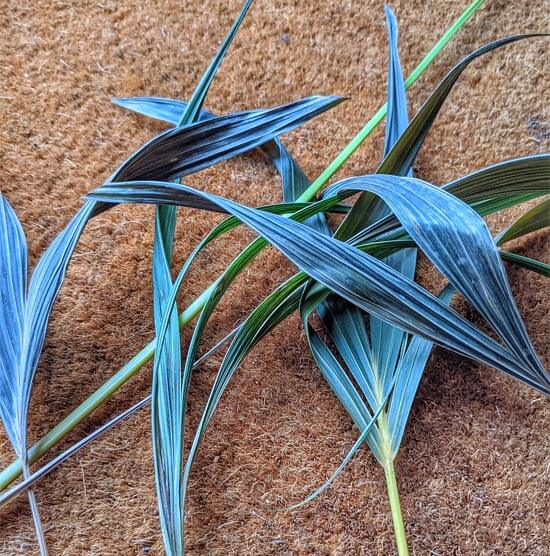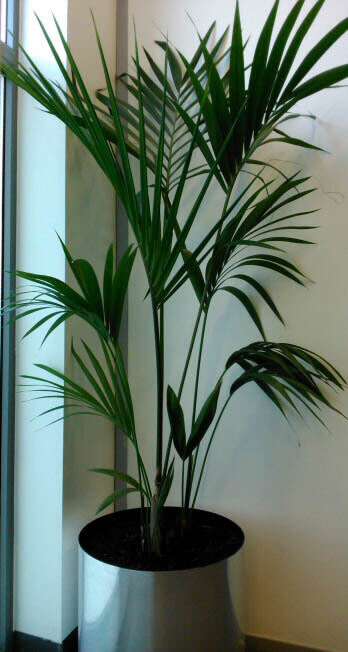Howea is a genus of only two palms, Howea forsteriana (Kentia Palm or Thatch Palm) and Howea belmoreana (Sentry Palm) both of which can be grown as indoor plants.
Although some of the most expensive palms you can buy, they're both attractive and come with a natural cast-iron constitution and are therefore often well worth the investment.
You could be thinking "Yeah Okay, none of my houseplants look good for very long in my care", but these plants will prove you wrong. Seriously, they're one of the most trouble-free and easy going houseplants I own. On top of this, they continue to look good, pretty much regardless of care. I'm not saying they're invincible, but they're certainly up there.
Kentia Palms can be grown in difficult locations, like this one at the bottom of a staircase.
In general, all palms make fantastic houseplants that give an air of the exotic and are a favorite large office plant used by interior decorators. This isn't a modern houseplant though, Queen Victoria was a huge fan almost 150 years ago. So it definitely gets the royal seal of approval.
Additional perks you get from palms are that they consistently rank highly when it comes to removing pollution from the air, they also transpire heavily making them brilliant natural humidifiers.
Kentia Palm Vs Areca Palm
The Kentia is often confused with the Areca palm and vice versa. They both have similar looks from a distance, but the trick to telling them apart is to look at the leaves. The Kentia has wider and bigger leaves that are a little more coarse than the more slender feather like leaves found on the Areca.
In some people's minds, they come attached with a "difficult" rating, but again we're telling you this is not the case with the Kentia Palm and this reputation is largely unfounded. Our care instructions below will provide you with everything you need to know and it's easy stuff, even for beginners.
In addition to the instructions, remember these tips - never repot too frequently and never prune a growing stem or try and yank dead parts off (always cut instead of pulling) and then the only "difficult" aspect is going wrong with them in the first place.
We don't normally combine two different houseplants into one profile, but the care requirements of the Kentia Palm and Sentry Palm are identical and the plants are so similar looking people often get them confused anyway. This seems a good place to start as any so let's get the identification issue sorted out first.
The Kentia has flatter and softer fronds with elegantly drooping leaflets and adapts much better to life in a pot than H. belmoreana.
Large hard stiff plants sometimes aren't wanted in homes as they can look harsh and be physically irritating to passers by if they brush up against them. Consequently, it's the Kentia that tends to be a lot much more popular as a houseplant. In fact, we'd wager around 90% of Howea palms you can buy as houseplants are probably the Kentia.
Photo showing a leaf of a Howea forsteriana (Kentia Palm).
In comparison, H. belmoreana has slightly curved leaves with erect stiff leaflets. It doesn't do as well in a pot as H. forsteriana because its roots prefer to have less restriction which a plant pot naturally doesn't allow.
For this reason, H. belmoreana tends to more popular as an outdoor garden plant (in subtropical climes only of course!) therefore unless you can provide a deep pot and an out of the way area in your home it might be best to keep with the status quo and pick the Kentia over the Sentry.
Photo showing a leaf of a Howea belmoreana (Sentry Palm) by Granitethighs.
Both plants are expensive to buy and we won't pretend otherwise. But they can both make a bold statement piece whilst looking handsome for years and you'll likely get more bang for your buck than smaller or cheaper houseplants. If you have a large space to fill, this palm could be a great fit.

Hi, I'm Tom!
If you're like me and enjoy the challenge of growing houseplants and getting them to thrive, then Ourhouseplants can help. This website shares my knowledge and years of growing plants and provides (hopefully) helpful advice on properly caring for your indoor plant friends.
Low light is acceptable, deep shade will also be tolerated for a short time, more so than most houseplants for sure, but it's not ideal.
A situation in direct sunlight will likely prove too much for your plant and should be avoided to prevent scorch marks on the leaves. These plants do need some shielding. The best balance between growth, health and good appearance is a decent semi-bright spot.
Palms are thirsty plants and in most growing locations you'll need to be watering frequently to ensure the soil remains moist during the parts of the year when they're in active growth. The only time you need to reduce water is in Winter or in very low light spots, but even then the soil should still be a little moist rather than completely dry.
Your plant won't grumble with some sporadic dryness at the roots, but if this happens too often or for too long the leaves will get brown tips or start turning yellow.
Make sure your chosen pot has good drainage because trapped water will end up creating soggy and swampy conditions which both the Kentia Palm and Sentry Palm passionately dislike.
A Howea forsteriana growing in a brightly lit area (but without direct sunlight), photo by Pali
The short answer to this is nice and simple. In the average home, humidity levels are unlikely to be a problem. This palm will deal with either low or high humidity levels quite well with few side effects.
The longer answer is that if you want to grow your plant in a room that is heavily heated or air-conditioned you'll need to make sure the level of humidity around the plant is medium to high. The easiest way to achieve this is through misting or growing it on a pebble tray, but there are other methods you can use.
There are two main reasons for doing this, firstly to deter Red Spider Mite which is the number one Howea insect pest. The second reason is that the leaflets are long lived, which means any brown tips that are caused by dry air will remain for a loooong time before new fronds grow to replace the damage. Higher levels of humidity should keep your plant looking pristine.
Palms are thirsty plants and so you need to be watering frequently
A weak feed every couple of months is all you need to be aiming for here. As usual, if the plant isn't growing, for example when it's cold or in a dark position, then you don't need to feed at all because it will not need the extra nutrients you're pouring into the soil.
Average warmth is needed for growth which means between 15°C (59 °F) - 25°C (77°F). Ideally, night time temperatures should be on the cooler side, but never lower than 10°C (50°F) at any time.
Almost all Palms resent root disturbance so rough repotting or doing it frequently can be damaging. Fortunately, it takes quite a while for the roots to fill their pots anyway, so these plants only need to be done once every couple of years at most.
Very young and small plants may need to be repotted once a year or so until they reach a mature size and their growth slows.
The Sentry Palm (H. belmoreana) will need a deep pot, and both varieties should be firmed / packed into their new homes by compacting the fresh compost around the root ball. A bit like tucking kids up at night, the roots like to be snug, but don't overdo it and suffocate them.
We just use standard potting compost you can buy from any good store. They're not too fussy. Do avoid anything too heavy or too sandy which won't hold water.
Pruning Tip - To prevent accidental stem damage always remove dead growth with a pair of sharp scissors rather than trying to pull it away.
These palms are expensive for a few reasons. One of these is because propagation is very difficult and when you factor in their slow growth rate it takes years to get a plant of a reasonable size. Even though many of the ourhouseplants.com team are experienced we would rather just go and buy a new one rather than attempting to propagate either of the Howea Palms.
In any case, the only way to really do this is through seed and a high temperature is needed for germination, but even then you could be waiting between 2 to 12 months before sprouting starts. You won't be able to just buy seeds either due to the heavy regulation of these plants, so it will depend if your current one produces seeds itself. Which is fairly rare on plants grown indoors.
You can of course divide very congested plants by taking the plant out of its pot and gently separating some of the stems if you want. But fair warning, this will drastically change the look of your palm, from one that's bushy and full, to one that's a lot more sparse and slender.
The Kentia Palm growth rate is really slow, even if you provide good light conditions and water correctly. In fact you may only get a few new fronds every year. In lower light conditions you might not get any new growth at all! So if you want to end up with a big plant, just cheat and pick the biggest you can afford at purchase time.
This Howea, although beautifully tall and impressive is likely to be at least 10+ years old. Photo by Someone10x
In their natural habitat, they can reach 3 m (10 ft) in height. Unless you've got a location with exceptional light levels, very few indoor plants will even get close to that.
The reality here is that most plants don't get much taller than what you have at the point you've brought them. There are exceptions of course and if you're one of those fantastic growers we want to hear from you in the comments below! We're not jealous of your skills at all... Well, maybe a little.
Beautiful flowering palms are very rare and neither the Kentia Palm nor the Sentry Palm can claim something different. Unremarkable blooms before quickly becoming seed pods do appear on occasion, but it's all about the foliage.
These striking palms are fine to share your home with pets that like to nibble leaves because these palms aren't poisonous.
We've got three tips for you:
Kentia Palms are not multi-stemmed, so this is actually a pot of several plants growing together
Most Light Conditions Will cope with low light as well as bright locations. Just avoid any no-light areas and intense direct sunlight areas in your home.
Moderate Watering If the light levels are good and the temperature is warm, expect to water once or twice a week. In lower light locations or if the temperature is on the cooler side you'll likely be looking at once every two weeks.
Temperature The ideal range is somewhere between 15°C (59 °F) - 25°C (77°F). You're plant won't grow if temperatures are cooler than this and you should avoid anything close to sub-zero.
Feeding Try to fertilise a little, once a month or every other month during Spring and Summer.
Parts are dying
This isn't necessarily a problem. It's normal for lower stems (and sometimes even quite new ones) to brown up and die. When this happens, carefully cut away the dead or dying parts to keep things looking attractive.
When Kentia Palm leaves die they can go grey with an almost blue tint
If there are significant parts of the plant looking ugly and ill then there is a problem. Seriously reassess how you are treating your Palm, cross-reference with our care instructions detailed above, especially the watering instructions and thoroughly inspect for Red Spider Mite or Thrips.
Pests
Palms readily attract Red Spider Mites. They might be hard to spot at first, but their sticky cobwebs should draw your attention in time. Eradicate this pest as soon as you can, because a long term infestation will eventually do irreversible damage in the form of brown, diseased looking leaves.
Leaves with brown edges or tips
Normally this is a sign of very dry air so increase the humidity to prevent this or move it to another part of your home. If that's not feasible you'll need to cut off the brown tips, make sure you follow the shape of the leaf to prevent the "haircut" from looking unnatural.
Leaves have brown spots
Overwatering, or the temperature is too cold. The brown spots are permanent, so you'll have to leave them or cut them away and improve how you're treating the plant to prevent further leaves from becoming affected.
Leaves have brown fluff
You might notice weird brown fluff-like material on the underside of the leaves. If your eyes widen in horror and you clutch your chest at the sight then we're feeling you. But no need to panic, this is actually totally fine.
Fluffy brown husk like material can often be found close to the base of the plant and as new leaves emerge from low down, it's common for some of this fluff to get stuck and move up the growing leaves. You can just brush if off. No drama at all, and definitely not a pest to be concerned about.
Sometimes these plants will have brown fluff like bits on the underside of the leaves
Yellow leaves
Often this is a strong sign that the root ball of your Sentry Palm or Kentia Palm has been allowed to dry out, usually during the warmer months of the year. Keep the soil moist during this period to keep the yellowing away.
My first experience with this plant was rather dull. We had a wide collection of different houseplants in a shared office space growing in fancy silver looking tubs. A number of them were Kentia Palms and just below is a picture of one of them. The maintenance was carried out once every few weeks by an external indoor gardener who would turn up on-site and water all the plants in the office.
I worked in this building on and off for just over 10 years and during this time many of the plants were replaced, however not the Kentia Palms. Oh no, these were lifers and were sticking around for the long haul. In all that time I don't think they replaced a single one.
Howea palms are normally slender and can be fairly tall for a houseplant
Despite only visiting fortnightly, I do remember thinking the indoor gardener must have had amazing green fingers as they never looked tatty, or badly cared for. In hindsight, it was the Howea forsteriana cast-iron constitution at play.
I can't stress how tough and easy going these palms are. They can be expensive, but with only basic care, they could be around for decades. - Tom
The only thing that put me off was the look. They just seemed "sparse" so I never brought one for my home.
Fast forward a few years and I noticed the way they were sold changed. As you can see from the picture above there are only a few stems per pot, but if you whizz up to the very first photo in the article, that one has a very different appearance as it has many more stems packed in.
Ultimately these plants (in my opinion) look significantly better when many stems growing in one pot. The whole plant transforms and gets a shrubbier look and brightens up the surrounding space.
Another perk I discovered was that these plants do perfectly well in poorly lit spaces. I think it truly rivals the Peace Lily and Aspidistra in the ability to tolerate low light stakes. It's superbly versatile. I enjoy it so much I have two in my home. They score a 10/10 from me.
